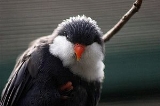
Blue Lorikeet
Encyclopedia
The Blue Lorikeet is a small lorikeet from French Polynesia
and the Cook Islands
. It is also known as the Tahiti Lorikieet, Violet Lorikeet, Tahitian Lory, Blue Lory, Nunbird, and the Indigo Lory. It was formerly found on 23 islands around Tahiti
, but now restricted to perhaps eight islands: Motu, Manuae, Tikehau, Rangiroa, Aratua, Kaukura, Apataki, Aitutaki, and possibly Harvey Island and Manihi. Its plumage is mainly dark blue and it has a white area over its upper chest, throat and face. The first captive breeding in the UK was by the Marquess of Tavistock in the 1930s. He was awarded a silver medal by the Foreign Bird League for this achievement.
, including cats, rats, Swamp Harrier
s, and mosquitoes carrying avian malaria.
French Polynesia
French Polynesia is an overseas country of the French Republic . It is made up of several groups of Polynesian islands, the most famous island being Tahiti in the Society Islands group, which is also the most populous island and the seat of the capital of the territory...
and the Cook Islands
Cook Islands
The Cook Islands is a self-governing parliamentary democracy in the South Pacific Ocean in free association with New Zealand...
. It is also known as the Tahiti Lorikieet, Violet Lorikeet, Tahitian Lory, Blue Lory, Nunbird, and the Indigo Lory. It was formerly found on 23 islands around Tahiti
Tahiti
Tahiti is the largest island in the Windward group of French Polynesia, located in the archipelago of the Society Islands in the southern Pacific Ocean. It is the economic, cultural and political centre of French Polynesia. The island was formed from volcanic activity and is high and mountainous...
, but now restricted to perhaps eight islands: Motu, Manuae, Tikehau, Rangiroa, Aratua, Kaukura, Apataki, Aitutaki, and possibly Harvey Island and Manihi. Its plumage is mainly dark blue and it has a white area over its upper chest, throat and face. The first captive breeding in the UK was by the Marquess of Tavistock in the 1930s. He was awarded a silver medal by the Foreign Bird League for this achievement.
Description
The Blue Lorikeet is 18 cm long with a short rounded tail. Its plumage is mainly dark blue and it has a white area over its upper chest, throat and lower face. Erectile feathers on the top of its head show light blue streaks. Its beak is orange and its irises are yellow-brown. It has orange legs. Adult males and females have identical external appearance. The juvenile lacks the white plumage of the adult and has a dark grey-blue face and lower parts. The juvenile also has a black bill, dark brown irises, and its legs are orange brown.Feeding
Blue Lorikeets depend on coconut palms for nesting and some of its food, and will frequent cultivated areas. They also roost in palm trees, rising at dawn and calling and preening before feeding. They are usually found in small flocks of less than ten birds. They are active birds, feeding on nectar, insects and ground forage.Status
They are endangered primarily by invasive speciesInvasive species
"Invasive species", or invasive exotics, is a nomenclature term and categorization phrase used for flora and fauna, and for specific restoration-preservation processes in native habitats, with several definitions....
, including cats, rats, Swamp Harrier
Swamp Harrier
The Swamp Harrier also known as the Marsh Harrier, Australasian Harrier, Kāhu, Swamp-hawk or New Zealand Hawk is a large, slim bird of prey in the family Accipitridae.-Description:...
s, and mosquitoes carrying avian malaria.

